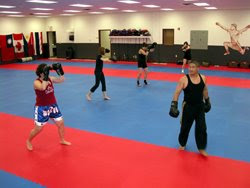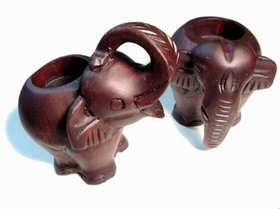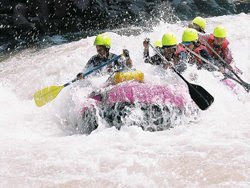 There are a number of lovely festivals and fairs in Loei including those to celebrate cotton, which is a major industry, but none to match the unique yearly event which is quickly gaining an international profile and reputation
There are a number of lovely festivals and fairs in Loei including those to celebrate cotton, which is a major industry, but none to match the unique yearly event which is quickly gaining an international profile and reputation
This is a country full of ghosts. Nobody can be sure, but it is thought that even misty and gloomy Scotland cannot match the concentration of ethereal beings flitting around nightly here in the Land of Smiles. The sheer number of Thai spirit houses outside most dwellings (and incidentally the Chateau de Loei vineyards) attests to the perceived necessity of providing a small residence for land spirits, which might otherwise go seriously bump in the night after being displaced by human activity. The variety of “Phii” as they are called, is endless, and it is against this background that Loei’s wonderfully unique festival of Phii Ta Khon should be outlined.
People argue that the name is either a corruption of the Thai language meaning “Ghosts with Human Eyes” or “Ghosts Follow Villagers.” Whatever the exact origin, this three-day “Thai Halloween” is an extraordinary event held annually in June or July in the village of Dan Sai, 80 kilometres from Loei town, where a similar but smaller festival also takes place. Some say the 200-year-old festival has roots in Buddhist folklore when delighted folks and local sprits emerged to celebrate the emerging sage’s return to the city after a period of absence. It is certainly linked to merit making, and a call for rain, but a likely genesis lies in ancient fertility rites. It is the ‘ghosts’ that define and dominate this event, making it uniquely and dramatically impressive.
 Hundreds of men appear dressed in ragged patched robes, wearing either hilarious or horrific masks with grotesquely exaggerated features, many mud-covered for that extra-ghoulish effect. The effect is stunning as this bizarre procession moves slowly through the town, no one ghost dressed the same, but most of them armed with phallic-shaped ‘weapons’ of all designs sizes and colours which are brandished threateningly at the crowds of delighted onlookers.
Hundreds of men appear dressed in ragged patched robes, wearing either hilarious or horrific masks with grotesquely exaggerated features, many mud-covered for that extra-ghoulish effect. The effect is stunning as this bizarre procession moves slowly through the town, no one ghost dressed the same, but most of them armed with phallic-shaped ‘weapons’ of all designs sizes and colours which are brandished threateningly at the crowds of delighted onlookers.
There is no limit to this penile creativity, with some oscillating nicely on springs, others popping unexpectedly out of concealed spaces to whoops of embarrassed delight from the crowd. Some are so uniquely outrageous that the ghosts are persuaded to part with them for an agreed sum, and they can end up as unlikely collector’s items in stately homes, upstaging priceless antiques. Music, clanging cowbells, dance, revelry, and appropriately, enough noise to awaken the dead accompany the weird and amazing sights.
The first two days of this amazing Oriental Mardi Gras are devoted to everything defined as fun - parades, contests, prizes, sporting events, and bamboo rain-making rockets which roar into the sky. The third day is less boisterous and marked by religious sermons and merit making, before the masks are finally cast into the river, and this memorable event is over, for another year.
Loei is an ideal destination for mildly adventurous folks who love nature, and wish to experience a unique area of Thailand, relatively unaffected by the known negative effects of international tourism. Hiring a vehicle and exploring the province opens up an unbeatable mixture of travelling experiences, including forays along the Mekhong River, which is less than 50 kilometres away.
Further afield, major towns, interesting in themselves, include Phetchabun (80 kms) Khon Kaen (120 kms) Udon Thani (143 kms) and Nong Khai (170kms) where the Friendship Bridge connects Thailand with Laos over the Mekhong. For the more athletic, the National Parks described above are some of the most beautiful in Thailand, but best visited outside of the rainy season between June to October.

Loei province occupies 11,424 square kilometres of the upper northwest part of Isan. It is located roughly 520 kilometres from Bangkok, and nestles in the Loei River valley, which extends northwards 47 kilometres to the picturesque border town of Chiang Khan on the Mekhong River. The mountains which rise to 1500 metres enclose some of Thailand’s finest nature reserves, and shield a patchwork of fertile plains and verdant valleys. Temperate flora including pines and deciduous trees thrive on the higher slopes, the latter turning to glorious autumnal shades in November and December.
At these altitudes, night frost can occur during November to February, giving an almost alpine feeling to the peaks. It is perhaps this aspect which inspires some travel writers to exaggerate the climate with dramatic statements about “temperatures plummeting below freezing” which of course applies only to high altitudes during the night. Loei town may be nippy when the sun goes down in the winter season, but it certainly doesn’t have icy streets. It is similarly painted as “the hottest province, with temperatures over 40C in April and May” a level also reached by other parts of the country, - but with no high mountains offering an escape from the heat.
 What to Do
What to Do
For those who wish to relax, Loei’s languid and laid back feeling is admirably conducive to doing very little, and wandering around the small town or strolling along the river can easily see half a day and a whole roll of film pass by whilst absorbing the local sights.
The main attractions lie in the surrounding province however, most of them made by Mother Nature, and all of them memorable. Aside exploring the vast National Parks, touring slowly by car treats the eye to unfolding panoramas of delight as the countryside reveals its vignettes of village life. At sunrise or dusk, these images can seem surreal in their mix of light and shade, colour and texture, profiles and patterns. Caricatures of remote rural Thailand appear and reappear, each one similar, yet always different, inevitably deserving a backward glance, or a foot on the brakes and a fumble for the camera.
Along the road, brightly coloured gourds “Nam Tao” hang out for sale. Displayed by the dozen and swinging in the breeze, these natural water containers traditionally carried into the fields by the farmers make an eye-catching sight. Water buffalo add their benign and benevolent stares to the white smiles hidden underneath the straw brimmed hats of peasants as they look up to see you momentarily enter their lives.
What to See
In the town itself there is little of interest apart from the local market by the river, and the pleasure of finding a restaurant and watching Loei go about its daily work, as you enjoy doing just the opposite. An equally pleasant experience is to have lunch outside the city at Hua Krating Lake, where diners aboard floating bamboo salas are served by boatmen armed with tasty local treats. Raising the flag on your raft indicates you are ready for the next course, or second helpings of the same. There are lovely views from here and this is a lively people-spotting venue, particularly at weekends.
Some 30 minutes south of the city, Suan Hin Pha Ngam Park forms part of a limestone mountain range eroded over centuries to form an interesting shape similar to that in Kunming, capital of China’s Yunnan province. Often referred to as “Kunming Mountain” a well-maintained path leads through some challengingly tight boulder spaces up to the panoramic peak.
A major tourist attraction some 70 kilometres from town is the vast flat-topped summit of the table mountain, Phu Kradung. Reached after a mildly strenuous 5-kilometre climb of 3-4 hours, with steeper sections assisted by bamboo ladders, the superb national park covers an area of roughly 350 square kilometres, at an average altitude of 1300 metres. Traced through this ambrosia of natural wonder are 50 kilometres of mostly level walking trails whose scenic routes on open grassland are enhanced by splendid trees, including stands of maple, beech and oak, handsome companions to the graceful pines.
Although the accepted origin of the name “Bell (Kradung) Mountain” is the corresponding shape, some say it has roots in the wild bull (Kratin) which used to inhabit this high wilderness. This may be so, for amongst the abundant vegetation, including rhododendron and giant azaleas, timid wild creatures still retreat at the sound of human footsteps. Wild elephants, panthers, jackals, bears, boars and monkeys are on the list of residents here, and even tigers are talked about. This is obviously not a day trip, and accommodation is available in bungalows and tents provided by the Forestry Department with whom bookings must be made well in advance, avoiding if possible weekends and Thai public holidays, which tend to be heavily booked. The park is closed during the rainy season, usually June to early October.
The smaller national park of Phu Reua (Boat Mountain) 49 kilometres from town has a summit of 1365 metres which is accessible by vehicle, and provides stunning views southwards over the town some 50 kilometres distant, and northwards towards Laos. On foot, the track leads up first through tropical vegetation to evergreen and pine forests, an easy 6-kilometre hike, taking roughly 3 hours. The park covers 120 square kilometres and takes its name from the junk-shaped outcrop at the summit. Marked hiking trails make it easy to appreciate the abundance of flora and fauna.
Highlights include the “Turtle Rock” because of its shape, and “Gold Cliff” which is covered in gold-coloured lichen. The Buddha image at the summit is a pilgrimage site. Overnight accommodation is available as above.
Less visited, strictly supervised and best explored on a 2-night guided tour organised by the Forestry Department, are the high and richly wooded slopes of Phu Luang (Royal Mountain) which is 49 kilometres from town, and rises to 1550 metres.
This nature reserve is covered with an immense variety of tropical and temperate flora, including deciduous and coniferous zones. It is also home to a number of wild animals including tigers, although these are rare sightings. The park is closed during the rainy season from mid-July to early October.
 Further afield and spreading over into the neighbouring Khon Kaen Province, the 350 square kilometres of the Phu Pha Man National Park has a number of interesting caves with pre-historic wall paintings. Other local caves include Tham Maholan, the site of a small temple, and Tham Bhothisat, a large hilltop cave with 14 different caverns.
Further afield and spreading over into the neighbouring Khon Kaen Province, the 350 square kilometres of the Phu Pha Man National Park has a number of interesting caves with pre-historic wall paintings. Other local caves include Tham Maholan, the site of a small temple, and Tham Bhothisat, a large hilltop cave with 14 different caverns.
One startling stretch of countryside in the Phu Rua district is guaranteed to make you look twice. More reminiscent of the south of France than tropical Asia, the hectares of vines growing in the cool air and rich earth introduce you to Chateau de Loei, the brainchild of Dr Chaiyudh Karnasuta, who recognised that this combination of climate and soil were ideal for grape cultivation. Proving the many sceptics wrong, he went ahead and established Thailand’s first premier winery and Thailand’s first serious attempt at viniculture. The resulting vintages were launched in 1996: a fruity red made from Syrah grapes, and a fresh tasting white from the Chenin Blanc variety. With expertise borrowed from France and Australia, Chateau de Loei coaxes two crops a year from the willing vines, and produces half a million bottles annually, a bounty which has found appreciative markets in Europe, the USA and Japan as well as satisfying the palates of patriotic oenophiles in Thailand.
Conducted tours of this unusual Thai attraction include an interesting description of wine making techniques, and the opportunity to purchase other locally made products, including macademia nuts, oranges, lychees, tamarind, longan, and vegetables.
Other sights around Loei worth mentioning are the large Buddha image and illuminated cave at the Erawan Caves (50 km) the lovely countryside surrounding Tha Li (47 kms) and the picturesque riverside town of Chiang Khan (47 kms)
 How to get there
How to get thereWhile Loei is easily accessible by road, one needs to use Udon Thani or Khon Kaen railway stations to reach Loei by train. A commercial airport is situated 6 kilometers from the town center.
As for river transportation, local residents use the Khong River to connect to Laos.
By Car
Route 1: From Bangkok, take Highway No. 1 to Saraburi and Highway No. 21 via Phetchabun and continue the trip along Highway No. 203 via Lom Sak, Dan Sai and Phu Ruea to Loei. Total distance is 520 kilometers.
Route 2: From Bangkok, take Highway No. 1 to Saraburi and Highway No. 2 via Nakhon Ratchasima to Khon Kaen, then continue driving along Highway No. 12 via Chum Phae before turning left into Highway No. 201 and proceed to Loei via Wang Saphung. Total distance is approximately 540 kilometres.
By Bus
Buses depart from Bangkok’s Northern Bus Terminal (Mochit 2 Bus Terminal) to Loei every day. There are VIP (24-seat) buses departing at 8.30 p.m. and 10.00 p.m. while air-conditioned and regular buses depart on a daily basis. Daily buses are also operated on the Bangkok-Dan Sai-Phu Ruea route. For more information call 0 2936 2852-66
By Train
Regular trains depart from Bangkok’s Hua Lamphong Railway Station (Tel. 1690, 02 223 7010-20) to Railway Station located in Udon Thani province. Then take a bus on route Udon Thani – Loei to the provincial city (Loei). Call.1690, 0 2233 7010, or 0 2223 7020 for more up-to-date information, or contact Udon Thani Bus Terminal at 0 4222 2061. Alternatively, visit http://www.railway.co.th/ for more details on schedules and fares.
By Air
Visitors can fly from Bangkok to Phetchabun, Udon Thani or Khon Kaen and continue the trip to Loei by bus. For more information, call Thai Airways International at tel.: 1566, 0 2628 2000, 0 2280 0060.
Air Andaman flies to Loei from Bangkok three times a week. For updated flight schedules, contact 042 81 2344.





























